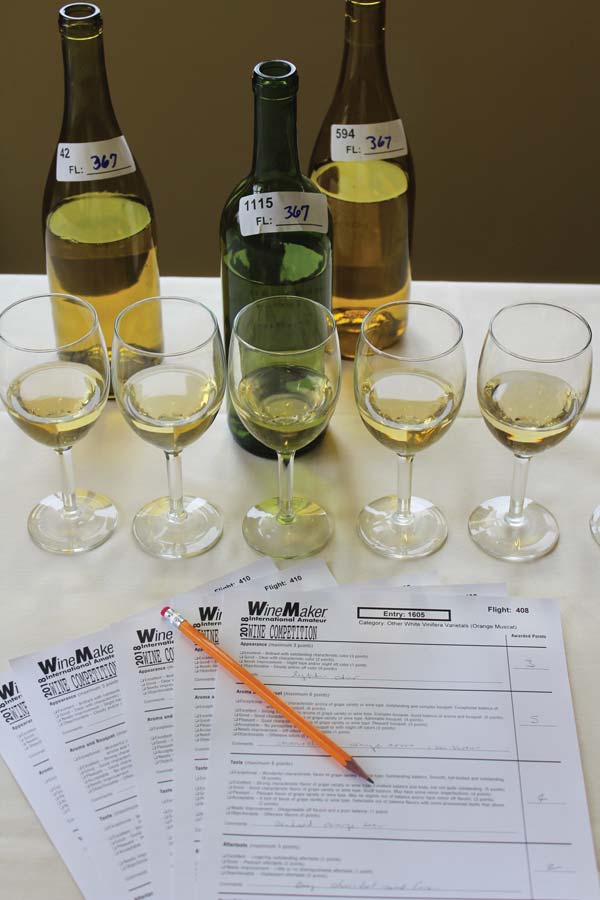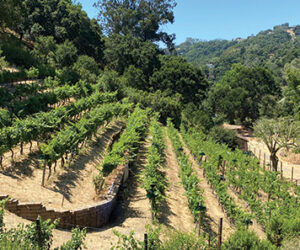Sensory evaluation and judging wine
Critically evaluating your own homemade wine can help you to improve its quality. Developing these skills will also give you a deeper appreciation of wine made by others. While you don’t need to use the fancy adjectives found on the back label, it does help to put some precise vocabulary into your wine appreciation. Using a quartet of your senses — sight, smell, taste, and touch (in the form of mouthfeel) — you can create and describe a comprehensive picture of the wine in front of you. A useful extension of thoughtful sensory evaluation is judging wine in competition. Winning a medal or a ribbon is fun, but the real goal is consistent and improving production of high-quality wine.
Your senses of smell and taste are by far the most important ones in wine evaluation. Of the five basic tastes — salt, sweet, bitter, sour, and umami — wine encompasses mostly just sweet, bitter, and sour. How then do we recognize and appreciate so many different wines? That mostly comes down to aroma. Unlike the five tastes, sensory scientists estimate that over 10,000 aromas are distinguishable by humans. With the tastes in good balance and none of them jarring your senses, it will be the aroma profile that leads a wine to a high score at a judging.

Tasting your wine critically is a skill set all on its own and allows you to become a better winemaker when you can pick out amendable faults.
There is no single curriculum or certification to become qualified as a wine judge. The contest organizer decides what sort of characteristics the judges should have and recruits accordingly. To represent a cross section of knowledgeable wine drinkers, they will often look for judging panels that include winemakers, wine journalists, wine buyers, sommeliers, and wine educators. For the latter categories, there are some formal training opportunities. One of these is administered by the Wine and Spirits Education Trust, headquartered in London, England. Referred to as WSET, it offers courses in wine knowledge and appreciation around the world through a network of approved providers. Upon completing courses of study, students take exams to be rewarded with one of four levels of accomplishment. Beyond levels one, two, and three, level four also confers a Diploma in Wines.
Originally conceived as a program for workers in the wine and spirits industries, WSET is now often pursued by non-professional wine lovers. In contrast to the more than 10,000 people worldwide who have achieved the WSET diploma, the more advanced Master of Wine program (also headquartered in the United Kingdom) currently recognizes fewer than 500 Masters of Wine.
The American Wine Society offers a 3-year program to become a certified wine judge. Those in Canada will find an equivalent program offered through the Wine Judges of Canada organization. When one of these very well educated and experienced wine professionals is available to judge a competition, they are eagerly welcomed by organizers. But many more people come to wine judging without a specific certification, and you can do the same. A combination of experience, self-education, and practice can help make you ready to apply your sensory skills.
One good place to look is an extension of the magazine you hold in your hands: the annual WineMaker Magazine Conference. At the 2023 conference in Eugene, Oregon, there were several single-subject Boot Camps on Thursday and Sunday, with a three-track series of seminars all day Friday and Saturday. Whether you’re looking to hone your winemaking skills, learn to grow grapes, or improve your wine appreciation, there are sessions for you. Some of the Boot Camps and seminars include tasting opportunities. At the Friday night Tasting and Wine Sharing Party, tasting is the main event. You will find commercial wineries from the surrounding region pouring and talking about their wines. In addition, dozens of home winemakers bring wines to share and will happily discuss them with you. The conferences also offer optional tours of local wineries, presenting more opportunities to taste. Whenever you are wine tasting, consider taking notes to build your mental reference file.
Another skill-building opportunity is a home winemaking club. Like-minded people get together to teach, learn, make, and taste wine. I live in Sonoma County, California, and have attended meetings for two clubs right here in the county in addition to visiting a large and active club 90 minutes away in Sacramento. Some of the clubs hold their own wine competitions and recruit local judges. If you are interested but are not yet qualified to judge, the competitions also need volunteers to serve as stewards — the workers who bring wine samples to the judges. No special skills are required and you will learn a lot about wine tasting and judging.
If there is no club near you, you can organize your own events to sharpen your tasting skills. Gather a group of friends and family and try some judging on your own wines, along with some commercial examples. Taste the wines, take notes, and talk them over with your guests. When someone identifies a flavor or aroma that you missed, taste that wine again and see if you find it. Skilled sensory evaluation means detecting an aroma or flavor, recognizing it because you have encountered it before, and then having the vocabulary available to describe it. While sweet, sour, and bitter tastes can stand alone, aromas are almost always named by analogy to something else.
When I teach wine judging classes, I prepare a series of “doctored” wines using natural ingredients to highlight specific flavors or aromas. I present these to the group to help build recognition and vocabulary for wine judging. Using a box of neutral white or red wine, I fill pint (0.5 L) jars and add my flavor and aroma ingredients. For whites, these include 2 g/L of tartaric acid, 0.1 g/L of tannin powder, 15 g/L (1.5%) table sugar, and 50 mL/L grapefruit juice plus 50 g/L grapefruit peel. For red samples, I use 2 g/L tartaric acid in one, 0.2 g/L tannin in another, one basket of lightly crushed blackberries or raspberries in a third, and finally one sliced green pepper in the fourth.
Unlike the five tastes, sensory scientists estimate that over 10,000 aromas are distinguishable by humans.
Another teaching tool I have employed is synthetic aroma and flavor standards, particularly for identifying faults or flaws. FlavorActiv of Great Britain makes food-grade granular materials in small capsules. They ship to the United States, and I have found them very convenient for purchasing sensory standards. Again using neutral wines, I offer a few of the faults to my students. Most recently I have used Sour (excessive acidity), Reduced Sulfur Compounds/Mercaptans (rotten egg-related stink), Brettanomyces/Barnyard (marker of wild yeast infection), Phenolic (another indicator of spoilage yeast), and Acetaldehyde (bruised apple aroma indicative of oxidation).
Most commercial wine competitions I have participated in use panels of three or four judges each. Sometimes there is a moderator or panel coordinator to tally the scores and keep track of the paperwork. The panel is assigned a series of wine flights consisting of similar wines that are brought out already poured, labeled with only a code number, and usually about 6–10 glasses at a time. A panel may evaluate over 100 wines in a day so it is imperative that each judge is provided with a spit cup and every table has a dump bucket — you don’t drink the wine in a competition. Because of the large number of wines and the necessary rapid pace, judges usually assign simple scores of gold, silver, bronze, or no award — corresponding to the consensus medal the wine will receive. If all panel judges assign gold to a wine, some contests deem that wine “double gold.”
In contrast, many home winemaker judgings give explicit numerical scoresheets. The additional detail that such sheets provide can help efforts toward improved quality. Many such scoresheets are based on the UC-Davis 20-point scale. That judging system was devised by Dr. Maynard Amerine at the University of California at Davis in 1959. It was originally established to consistently evaluate experimental wines produced at the university. Judging wine at home and when teaching, I use my own slight modification of the Davis scale. This can be found at: winemakermag.com/technique/tasting-critically
The scoresheet includes guidance on point values for wine characteristics and includes space for the judge to add explanatory comments or make suggestions for improvement. Two points are allocated for appearance with two more for color. White and rosé wines should be very clear, even brilliant, to get one or two of the appearance points while some haziness might be allowed in a red, especially if it is very dark colored. In color, lighter wines should show no browning and reds should be varietally typical. A Pinot Noir may be a lighter red, but a Petite Sirah should be inky dark.
After these sight categories, four points are allocated for aroma and bouquet. Those terms refer to smells that originate with the grape itself plus those generated in the process of fermentation. The smells should be clean, pleasant, balanced, and varietally correct to garner all four points. Next is a bit of a backwards category — absence of volatile acidity (VA) aroma. These days, nearly all wines I encounter in competition are free of such aromas and therefore earn the full two points of the category. Perhaps in 1959 this flaw appeared more often, leading to its specific inclusion on the UC-Davis scale, but I rarely detect it in wines today. A slight, but noticeable VA aroma (vinegar hints) would drop the wine to one point and obvious VA would cause a zero.
Total acidity gets two points while sugar and body get one each. All of these are focused on balance and integration in the wine. Wine can taste harsh if total acid (TA) is too high and can seem “flabby” if TA is too low. A bit of sweetness helps balance a high acid wine but may be cloying if out of balance. Sweetness and acid are essential to some styles like ice wines. Body, also known as mouthfeel, reflects a combination of tannins and alcohol to achieve a pleasant fullness in the mouth, appropriate for the wine style. Flavor and astringency earn up to two points each. Once again, the judge is looking for a pleasant effect that is varietally consistent. To get both points for flavor, there must be no detectable off-flavor notes or inconsistencies with the wine style. Astringency should be pleasant and in support of the varietal objectives of the wine.
Finally, there is the widely subjective two-point category of General Quality. A judge may sit for a moment, think about the overall impression of the wine, and then award zero, one, or two in reflection of the general pleasure that derives from tasting the wine as a whole. If potentially helpful to the winemaker in interpreting the score, comments should be added. When specific winemaking flaws are suspected, those should be mentioned as well. For instance, browning in a young white wine may indicate oxidation from excessive exposure to air. If the color category has been marked down accordingly, the judge may note possible oxidation and recommend further efforts at avoiding it in the future.
Ready to try it? Print some scoresheets or just use a blank piece of paper and thoughtfully smell and taste your wine. Invite family, friends, or club members to join you. If there are other home winemakers around, have them bring wines, too. Consider making some sensory reference standards using neutral commercial wine as a base. Swirl, sniff, sip (and spit) through a series of wines. You are the judge!







